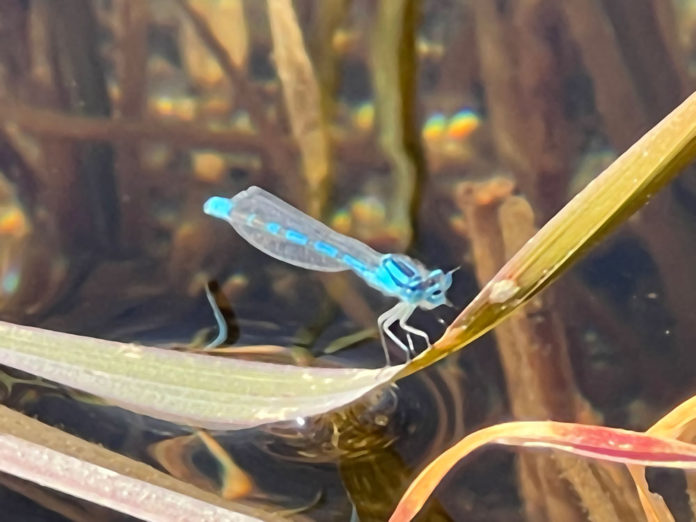
By Pierre Ratte
Dragonflies may be the lords of the flies. Their order, Odonata, dates back 300 million years, whereas the common house fly, Diptera, evolved around 80 million years ago. The common blue damselfly is more or less a slender cousin of larger, less colorful dragonflies. Both are found around freshwater ponds throughout North America, and are indicator species of ecological health preferring oxygenated aquatic habitats.

Eating 100 bugs a day, scooping prey out of the air with four basket-like feet, they eat on the go. Their predation success rate is 95%, compared to barn swallows’ 30-40% or bats’ estimated at 40-60%. No wonder they’ve survived 200 million years longer than other flying insects. This damselfly and many of its friends were very successfully picnicking in Yosemite.
Fun facts: At 300 million years old, dragonflies are reportedly the oldest winged insect. Prehistoric ancestors had wingspans of two and a half feet. Each of four wings moves independently allowing them to hover, fly forward and fly backward. Voracious predators reaching speeds of 33 mph, they nab prey whose max speeds are like standing still: mosquitos (1.5 mph), gnats (2.3 mph), house flies (5 mph). Compound eyes containing approximately 30,000 ommatidia—visual receptors—give dragonflies nearly a 360-degree field of vision for precision predation.
Dragonfly eggs are laid in or near water. A nymph emerges, enters the water and eats small aquatic fauna, undergoing several molts. The underwater stage lasts months or years depending on the species, until the nymph emerges, molts its exoskeleton and flies. Nearly ubiquitous, dragonflies inhabit every continent except Antarctica.
The Lord of the Flies, published in 1954 by William Golding, a British author and survivor of World War II, is an allegorical story of good and evil set in the context of 25 or so boys stranded on an island attempting to survive while maintaining civil order. They descend into savagery due to the inherent evil tendencies in humans. The title alludes to the lord of the demons, Beelzebub, or less colloquially, Baal-Zebub. Baal was a Philistine and Canaanite god associated with fertility, agriculture, sexcapades and child sacrifice. Hebrews strayed to worship Baal, until Gideon was called to destroy Baal’s altar and stop his people’s descent into evil.
The Lord of the Flies was made into a movie twice, in 1963 and again in 1990, the latter starring Balthazar Getty of the Getty Oil familly. The movie flopped at the box office, grossing $13 million on a production budget of $9 million.








